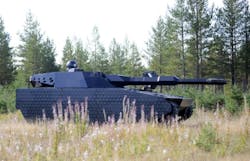BAE Systems temperature-changing tiles camouflage tanks in the infrared
Örnsköldsvik, Sweden--BAE Systems has tested "Adaptiv," which is a set of temperature-changing tiles that covers a tank and allows it to blend into its surroundings at thermal wavelengths. The sheets of hexagonal pixels can rapidly change temperature; onboard thermal cameras pick up the background scenery and display that infrared image on the vehicle, allowing even a moving tank to match its surroundings from one vantage point. Alternatively, Adaptiv can mimic another vehicle or display identification tags, reducing the risk of fratricide ("friendly fire").
A component of overall stealth
Current work focuses mainly on the infrared spectrum, as this is most important to the Swedish Defence Materiel Administration (FMV), which funds part of the work. However, BAE Systems engineers have combined the pixels with other technologies that provide camouflage in parts of the electromagnetic spectrum other than the thermal infrared at the same time, says BAE. When fully developed, this should provide all-around stealth, which should happen sometime in the next few years.
Trials by BAE Systems in mid-July showed that one side of a BAE Systems CV90 armored vehicle could be made effectively invisible or appear to be other objects, including a 4x4 vehicle, when viewed in the infrared spectrum.
Pixels, large or small
"Earlier attempts at similar cloaking devices have hit problems because of cost, excessive power requirements, or because they were insufficiently robust," says project manager Peder Sjölund. "Our panels can be made so strong that they provide useful armor protection and consume relatively low levels of electricity, especially when the vehicle is at rest in 'stealth recce' mode and generator output is low. We can resize the pixels to achieve stealth for different ranges. A warship or building, for instance, might not need close-up stealth, so could be fitted with larger panels."
The system, which can work over infrared and other frequencies, will be displayed in infrared mode on a CV90 armored vehicle at the UK Defence and Security Equipment International exhibition in London, England later this month (13-16 Sept.).

John Wallace | Senior Technical Editor (1998-2022)
John Wallace was with Laser Focus World for nearly 25 years, retiring in late June 2022. He obtained a bachelor's degree in mechanical engineering and physics at Rutgers University and a master's in optical engineering at the University of Rochester. Before becoming an editor, John worked as an engineer at RCA, Exxon, Eastman Kodak, and GCA Corporation.
